#MCST1010BattistaFall18
Explore tagged Tumblr posts
Text
Media Culture & Society- Denver Art Museum
For your assignment, you will look around at the exhibits and take photos of paintings and art that draws a connection with bell hooks and Hebdige’s concept of Subcultures. On your Tumblr blog, you will post images of the art along with specifically chosen quotes from either/both articles as a way to frame your photo assignment.
From the article, “Art on My Mind: Visual Politics” by Bell Hooks and the article, “Subculture: The Meaning of Style” by Dick Hebdige.
Rembrant
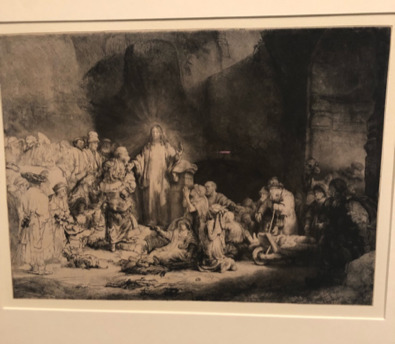
“Years ago most black people grew up in houses where art, if it was present at all, took the form of cheap reproductions of work created by white artists featuring white images; some of it was so-called great art. Often these images incorporated religious iconography and symbols” (Hooks, 7).
Rembrant

“We identified with these images. They appealed to us because they conveyed aspects of religious experience that were familiar. They fact of whiteness was subsumed by the spiritual expression in the work” (Hooks, 8).
Julie Buffalohead piece titled “Six Pack Colonialism”- These paintings by Julie Buffalohead portray her experience as a person with Native American heritage in modern day America. Her use of animals is to symbolize different tribes, attributes, and parts of their religion as well as to represent animals and their characteristics.
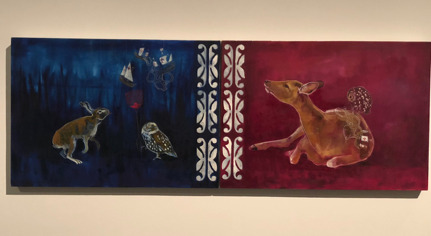
“Clearly, it is only as we move away from the tendency to define ourselves in reaction to white racism that we are able to move toward that practice of freedom which requires us first to decolonize our minds. We can liberate ourselves and other only by forging in resistance identities that transcend narrowly defined limits” (Hooks, 8).
Julie Buffalohead
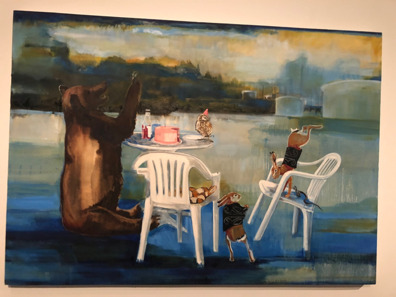
“Like Genet, we are interested in subculture – in the expressive forms and rituals of those subordinate groups… who are alternately dismissed, denounced, and canonized; treated at different times as threats to public order and as harmless buffons” (Hebdige, 1).
Julie Buffalohead
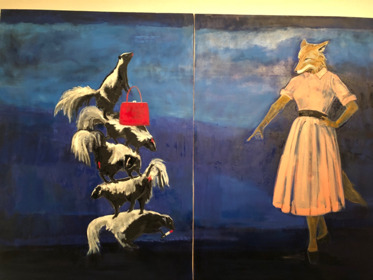
“For, just as the conflict between Genet’s ‘unnatural’ sexuality and the policemen’s ‘legitimate’ outrage can be encapsulated in a single object, so the tensions between dominant and subordinate groups can be found reflected in the surfaces or subculture- in the styles made up of mundane objects which have a double meaning” (Hebdige, 2).
2 notes
·
View notes
Text
The Internets relationship to capitalism: All take, no give.
Having worked as a network engineer for over a decade, and two of those years at an ISP/Cable provider, this subject has always been close to home for me. On one hand it is nearly impossible to explain the complexities that go into planning, designing, and implementing a functioning network to those outside the field. On the other hand I’ve always felt it important for people to understand because only then will they get a clear picture of the one sided relationship they are involved in.
As pointed out in the article “The Internet’s Unholy Marriage to Capitalism” by John Bellamy Foster and Robert W. McChesney, “the dominant wires that would come to deliver Internet service provider (ISP) broadband access for Americans were and are controlled by the handful of firms that dominated telephone and cable TV.” For context, in 1996 the Telecommunications Act of 1996 was passed in which the government subsidized large amounts of fiber optic network infrastructure through cities, and to residential neighborhoods. A large part of this has remained unused to this day. When you work in the industry there is a term named “dark fiber”. This is used to identify fiber optic cabling that has been laid underground that is currently not being used. Though a large amount of fiber has funded by the government and the tax payers we are still lacking when it comes to download speeds in relation to much of the civilized world. As of 2018, the U.S. ranks at 22n’d [1]. Moreover, the government does not own the dark fiber sitting under our feet, this fiber is owned by the service providers which the government must rent at high prices in order to perform many government and military functions.
Another glaring issue with service providers is monopolistic practices. Service providers have no-compete agreements for markets all over the U.S. This lowers options for consumers to the point of ISP’s becoming monopolies. If consumers don’t like the practices of the local ISP, that is simply too bad. I know this first hand since I have worked in this field.
As you can see, the relationship of ISP to consumers is very one sided. There is all take and no give.
[1] https://www.businessinsider.com/the-23-countries-in-the-world-with-the-fastest-internet-speeds-2018-7
3 notes
·
View notes
Text
Performative Acts Blog
Minimum 100 word analysis of gender performance. What does Butler mean by “gender performance?” In what ways is gender a stylized repetition of acts? Describe, discuss. Find a media example for support.
In the essay “Performative Acts and Gender Constitution” Judith Butler discusses how gender should not be determined by one’s physical sex, but rather by the repeated physical acts one commits. This idea is described by Butler as gender performance and is what she believes to be the determining factor of ones gender, i.e. if a female acts as a male then she is a male and vice versa. This idea can be seen in several forms of media such as shows like Modern Family for example, where two of the main characters, Cameron and Mitchell, are a homosexual couple who constantly act and portray themselves, as females, in order to help the director of the show accomplish their goal of depicting a gay couple. The director accomplishes this by having the two actors, Eric StoneStreet and Jesse Ferguson, repeatedly act in a feministic way. For example, in many episodes of the show the men act fashionably savvy and speak in high pitched tones, all while also being extremely emotional, all traits which historically belong to those of the female gender. Thus changing the men’s gender from male to female, in a sense, all by just changing the way the two men act.
3 notes
·
View notes
Text
Lab 3:
Corporation: The Walt Disney Industry
The Walt Disney Company started in 1923 in a small office in Los Angeles. Where he and his brother Roy would work on short animated films that they would collectively name “Alice Comedies.” Mickey Mouse would be born in 1928, followed by all of his friends shortly after. In 1937 Disney would produce, “Snow White and the Seven Dwarves.” Many laughed at the idea of a full length animated film, but when the movie was released, it was instantly popular. Because of its worldwide fame, Walt Disney was able to purchase over 51 acres in Burbank, CA, and start work on his studio, which would be designed specifically to produce animated films. Only in the late 1940s would Disney turn its attention to live action films. There would be four stages developed for four different types of films, and Disney would start its way to becoming the leading media conglomerate.
Disney was founded and made by Walt Disney, but after his demise Robert A. Iger took the seat of Chairman and Chief Executive Officer. The rest of the chairs are filled by other white people, there is no diversity within Disney’s executive offices, which can be problematic when creating media that is going to influence people worldwide. In fact, famous Disney director James Gunn was fired because of offensive Tweets he had previously made, some revolving around the concept of race. The Washington Post poses the question if it was really necessary to fire someone because of backlash from fans, or if Disney overreacted to the backlash in fear of losing money.
An example of Disney’s structure is included in Figure 1. Disney does both vertical and horizontal integration. From when they started they horizontally integrated by partnering with other production companies, and with creating new products off of their movies. However, the vertically integrate when they purchase companies such as ESPN or with the creation of their amusement parks, even though they use their movies and characters to get people into their parks, they did not have to create amusement parks in order to gain more fame for their films. Take this for example, Disney is building a nature themed resort for some of their older guests. Did they need to make this change? No, because Disneyland and Disneyworld are fun for the whole family. But they did, in order to target demographics without children.

Disney recently acquired Fox, Marvel, Hulu, The Simpsons, Star Wars, and others. Merging these companies together cost Disney a whopping 71.3 million dollars. Certain films and TV shows are expected to be halted as a result of the merge, with many fans growing upset at the lack of communication from the company. This NewsWeek article claims that this could be a falloff point for many of these smaller companies, with over 5,000 job positions to be laid off. However, this could be a really big move for Disney, acquiring not only streaming services but million-dollar movies and TV shows can be super beneficial if Disney keeps up with the original premises. However, if they screw up Star Wars or any of the Marvel movies they could face extreme backlash.
However, others see this as a corporate uprising. Saying that this could be the death of some of our favorite movies. Not only this, but also claiming that Disney owns too much already, and their continuation of integration is only making them more powerful. And some companies are giving in to and uprooting themselves in order to join the Disney corporation. Disney is an international company, with their movies and parks distributed in multiple countries.

The good news about buying all these corporations is that Disney already knows the way they have been distributed, and the ways it can improve. Disney was not shy about the purchase of Star Wars, or Marvel for that matter, because they have faith that they can make better movies that consumers already have interest in. The problem however, is that Disney is willing to fire hard working employees in these corporations, to replace them with Disney affiliated employees, which can lead to thousands without jobs. The reason this can be a conflict of interest for Disney is because the audience now sees them as every other heartless corporation. They don’t care about the little people, only making money. Disney has lost its innocence, once being known as a company who produced happy children’s movies, and now being seen as a corporate machine. This YouTube video is two guys who have sat down to sing about everything Disney owns, and I think it really shows how a lot of people are beginning to see Disney.
youtube
Overall, Disney is an extremely large corporation with a lot of influence over a wide audience. The receive money from multiple different sources along their vertically integrated system, shown in this chart here. And their revenue doesn’t just come from American citizens, but also from countries around the world. Disney is not going to stop globalizing or buying companies to merge with. Instead, they are going to continue doing what works for them, which is continuing to integrate with these companies to make more money. Disney has lost interest with the way it looks from the outside, and is now more concerned with what will make them the most revenue.
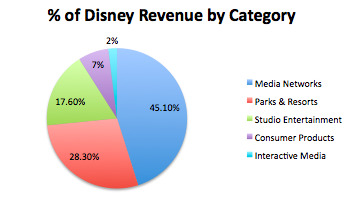
1 note
·
View note
Text
An American fairytale
This article talks a lot about class and how tv glosses the higher class. Giving us in the lower or middle class to look with awe in hopes we may one day have what they do. The difference is the people are treated as if they are the working middle class. A delusion that they don’t make millions.
“ this divide between the classes ensures that the working class are always receptive and thankful for the “good taste” The stowed upon them by the middle class” (Palmer 52)
This act gives a wide range of audiences that can relate. But just like all reality tv all cannot be real no matter the word “reality” being induced. They add this family act in order to be relatable to the audience. Where as we watch the Kardashian‘s because their rich, we watch Extreme makeover because we relate. A key difference between the two.
Family orientated fiction is more relatable because most have a family and have a high expedition to how a “loving” family and the American dream of a family should be.
1 note
·
View note
Text
Kick-Ass and harmful ideas around violence and revenge.
Kick-Ass is a 2010 action comedy based off the comic series of the same name about a comic book nerd named Dave Lizewski, who sets out to make his dreams of becoming a crime fighting superhero come true. He soon discovers very harshly that fighting crime involves actually FIGHTING crime and when you don't have powers or a super suit its not as easy as it looks. Dave is the typical nerd in high school that doesn't have many friends, isn't good at talking to girls, and the few friends he does have all share the same interest in comic books as himself. One day after a conversation with his friends on why no one has actually tried to become a superhero he decides to become one himself because he's tried of being pushed around and wants to feel powerful and stop criminals and bullies. So Dave goes home and orders a green and yellow wet suit and a pair of batons and decides to call himself “Kick-Ass”. When his new “super” suit arrives he does important “training” by posing and air boxing infront of his mirror admiring himself. On his way home after failing to scale between two buildings one evening in his Kick-Ass suit he come across two actual criminals trying to steal a car. His first instinct is to run but when he members he is not Dave at the moment but Kick-Ass he decides to internve also because he is now armed (his batons). The criminals initially laugh Kick-Ass off until he hits one of them in the head with his baton and a fight ensues. after a short scuffle Kick-Ass thinks he might have the pup hand until one of the criminals stabs him in the abdomen with a knife. Kick-Ass or Dave is quickly brought back to reality as he see his hand covered in blood and stumbles into the street only to be hit by a car.
This is Where Dave’s Kick-Ass story starts to turn into an actual superhero story and where the violence and vengeance start to permeate the story. After the car accident/ stabbing Dave is implanted with many metal bone replacements that make him more tolerant to pain. With this discovery he decides to intervene again as Kick-Ass when he learns the girl he likes is being harassed by an abusive ex boyfriend who also happens to be a violent drug dealer. Kick-Ass goes to the dealers apartment in an attempt to deliver a violent warning but instead once again is out of his element. After pulling a cheap taser and using it shorty on the drug dealer Kick-Ass is disarmed and surrounding by the dealers crew and is seemingly about to be executed, until a young girl in purple tights with a spear breaks in and violently slaughters the drug dealer and his crew leaving only Kick-Ass alive.
This is how we are introduced to Hit Girl and Big Daddy, a seemingly normal 10 year old girl and her ex cop father. However Big Daddy’s life is so consumed by vengeance for his ex criminal partner and crime boss Frank D’Amico. He has not only dedicated his and his daughters’ life to finding and killing D’Amico, but is willing to risk his own daughters life in order to train her to be a vigilante (going so far as to shoot his own daughter to get her used to getting shot with a ballistic vest on). Big Daddy and Hit girl recruit Kick-Ass on their mission thus sucking yet another person into Big Daddy’s quest for vengeance .
youtube
youtube
1 note
·
View note
Text
Media Culture & Society- Gender Performance in Glee
Minimum 100 word analysis of gender performance. What does Butler mean by “gender performance?” In what ways is gender a stylized repetition of acts? Describe, discuss. Find a media example for support.
youtube
In Judith Butler’s essay, “Performative Acts and Gender Constitution: An Essay in Phenomenology and Feminist Theory”, Butler discusses how gender is constructed societally by acts. Simply, men are men because they perform acts that men do, and women are women because they perform acts that women do. This is based on gender not sex which is biological, “…she clearly underscores the distinction between sex, as a biological facticity, and gender, as the cultural interpretation or signification of that facticity” (Butler, 522). The television show Glee is a great example of “gender performance”. In Glee, the characters Finn, Puck, and Mike are on the football team; all the other teenage boys on the show are shown as not “traditionally” men because they are not in football, an act for men. Quinn, Santana, and Brittany are on the cheerleading squad. The rest of the girls in the show are not as “cool” as they are because they aren’t on the cheer squad, a thing mostly for women. Although they are not on the cheer squad, the rest of the women in Glee are still acting the way society thinks that women should act because they are singing and dancing. The cheerleading coach, Sue Sylvester, does not act the way society wants her to as a woman. She is aggressive, loud, and wears track suits all the time. The show counters putting a character on television like her by making her, a not “traditional” woman, into the villain. She often gets cast as the bad guy in many of the seasons. This is unfair since men usually act the way she does and are praised for their assertiveness and guts while she is vilified for acting the same way.
4 notes
·
View notes
Text
Media Culture & Society: Race and Pitch Perfect
Compose a 100-word analysis of the article, focusing specifically on the ways the author examines the concept of "post-racial." Watch any TV text and provide an example of the ways race is problematically represented. Use a quote from the article to frame your analysis and bring in the Stuart Hall piece as needed.
youtube
In the article “Pretending to be ‘Postracial’: The Spectacularization of Race in Reality TV’s Survivor”, writer Emily M. Drew analyzes the way race was used in Survivor: Cook Island. In that season ofSurvivor, contestants are split into “tribes” based on their race and competed against each other first segregated and then desegregated. Of the many problems that emerge from this portrayal of race in a so-called “post-racial” world is the continuation of racial stereotypes. Drew wrote, “This season of Survivordemonstrated the ethnic and generational hierarchies within racialized groups and complex ways in which identity politics and internalized racism operate inside racialized groups, particularly the Latino and Asian American communities, neither of which gets represented as complex, diverse, or dynamic in television depictions” (Drew, 172). This quote reminded me of the way race is portrayed in the Pitch Perfect trilogy. Race is often used as a joke in the Pitch Perfect movies. Kimmy Jin is main character Becca’s (Anna Kendrick) freshman roommate and is Asian American. She has no desire to be friends with Becca, joins an Asian American club, and becomes friends only with other Asian people. Cynthia Rose is the only African American character. She is also lesbian. All the humor around her is lesbian jokes and about her being a triple minority (African American, a woman, and lesbian). Flo Fuentas joined the second movie and as a Latina immigrant from Guatemala all her jokes are about how hard her life was in Guatemala versus how easy things are in the US. The Pitch Perfect series has problematic representations of race but at least they do not pretend that they exist in a post-racial world.
2 notes
·
View notes
Text
Media Culture & Society- Inferential Racism and Peter Pan
100 word minimum analysis of the concept “inferential racism” as depicted by Stuart Hall. In what ways does inferential racism reveal itself in media texts? Provide a specific example and be prepared to discuss.
In “The Whites of Their Eyes: Racist Ideologies and the Media” by Stuart Hall, Hall describes the differences between overt racism and inferential racism in the media. Hall writes,
“By inferentialracism I mean those apparently naturalized representations of events and situations relating to race, whether ‘factual’ or ‘fictional’, which have racists premises and propositions inscribed in them as a set of unquestioned assumptions” (Hall, 20).
youtube
A good example of inferential racism is Peter Pan. This example boarders between overt and inferential depending on the version of Peter Pan. It may be more inferential since Peter Pan is a children’s book/play/movie and children just absorb the racist depictions of Native Americans without questioning them. In Neverland, there are three groups of people (and one ticking crocodile): the lost boys and Peter, Captain Hook and the pirates, and the “Indians”. The book, adapted from the 1904 play, called the Native Americans “savages” and described like a mob, “These ‘natives’ always move as an anonymous collective mass – in tribes or hordes” (Hall, 21). They call Peter “the great white father” after he rescues Princess Tiger Lily from the pirates. Later, they are depicted in the 1953 Disney Peter Pan movie as caricatures and even have the song “What Makes The Red Man Red?” It’s interesting to look at the adaptations made later to see how they dealt with the racist stereotype. Hook, 1991 movie with Robert Williams playing a grown-up Peter, leaves out the Native American tribe altogether. Peter Pan, 2003 adaptation, they are portrayed as Native Americans and really don’t play a role in the plot at all. Pan, 2015 adaptation with Hugh Jackman, depicts the tribe as native peoples from the planet they are on dressing them up in bright blue and red colors instead of portraying them as Native Americans from Earth. This inferential racism is easy to swallow in Peter Pan because it is a media text for children, so it seems harmless and it is not a major part of the plotline, so it is overlooked.
2 notes
·
View notes
Text
Media Culture & Society: Socio-Economic Class of the Bachelor Nation
100 word analysis of class construction and “reality” TV. Watch an episode of any “reality television” show that stereotypes class divisions. Analyze the show, break it down and apply language from the article to your analysis.
Bachelor Nation is comprised of three reality shows, The Bachelor (comes out in fall/winter), The Bachelorette (comes out in late spring/early summer), and Bachelor in Paradise (comes out in summer). It is a series of reality shows where people try to find their soul mate and try to end up engaged. The Bachelor features one man trying to find “the one” out of 25-30 women. The opposite is true for The Bachelorette, one woman and 25-30 men, and Bachelor in Paradise is a mix of men and women from the past shows who converge on a tropical island to fall in love and cause drama.
This show may not look like a good representation of class construction but that is because the messages are so carefully hidden. Gender constructs and performance are so much more obvious in this strictly heteronormative show. While there might be one bisexual woman on The Bachelor (to keep it “progressive”, inspire some girl on girl imagination, and to make sure there’s no chance of two women abandoning The Bachelor and running off into the sunset), there is never a bisexual man on the Bachelorette.
The class constructs are most prevalent on the first episode of each show (not Bachelor in Paradise) when new people arrive on the scene. It’s an episode of making new friends and forming in to cliques based on similar jobs and socio-economic classes. Working class people are rarely cast in Bachelor Nation. If they are cast it is because they are a third or fourth generation working class person, like Grant, a fourth-generation electrician, or Joe, who owns a grocery store with his family (it’s all about emphasizing family since they are trying to create families). It’s easier on the women’s side to have a more working-class job (that’s not truly working class). It’s ok on The Bachelor to be a nurse, teacher, or restaurant server (of course the woman couldn’t possibly make more than her prospective man). In every season, there is one model and several current or former pro athletes (on the woman’s side they have pro basketball dancers, and Pilates instructors). On average however, most contestants on the shows are middle to upper class managers, banker, business owners, all with college to grad school degrees.
Previously mentioned Joe, the grocery store owner, is a great example of how contestants treat working class to lower middle class contestants who make it past the first few weeks. Interestingly enough, Joe was one of the youngest traders on the Chicago Stock Exchange but he left that to own a small business, a grocery store. The show never talked about that impressive achievement however and tended to focus on his lower-class side (his Chicago accent did not help). He was targeted and bullied frequently for not fitting in with the fellow contestants due to his lower-class status. He was even in a fight on Bachelor in Paradise because someone insulted him too much. It’s all a very interesting look at what makes the perfect soul mate in reality show world.
youtube
2 notes
·
View notes
Text
Art Museum
In her Article “Art on my Mind” Bell Hooks speaks about the disconnect that occurs within black culture in regards to art. Hooks claims that many African Americans do not care for art because it is aesthetically pleasing, but instead prefer “Art (to be used) as propaganda,” which, “(is not) concerned with any old subject, context or form”(Hooks 3). By stating this Hooks is expressing that Blacks in America do not care for art if it is not making some sort of political or cultural outcry which speaks on behalf of African American oppression/culture within the United States, and that Blacks usually ignore the pleasure aspect of art all together. This is not only the case for African Americans but rather many other cultures which migrated to the United States. Many Americans with different cultural and ethnic backgrounds adopt this idea and do the same. Instead of creating a peace for the sole purpose of beauty these artists feel as if they are obligated to create artwork which holds a double meaning and pays homage to their heritage.
This was something I myself encountered while observing the artwork at the Denver Art Museum, but one piece caught my attention in particular: Julie BuffaloHead's painting “Blood and a Single Tree”. The art piece itself is aesthetically pleasing as the bright red colors ,form and texture used within the painting add face value to the piece, but upon reading the description of the work and discovering the artist’s heritage I could not help but stare into the painting wondering whether the art piece was somehow connected to BuffaloHead’s Native American heritage. After various seconds of examination I came to the conclusion that the painting was in some way tied to the BuffaloHead’s heritage as it depicted bipedal personified animals wearing human clothing, which are often traits which are given to animals within Native American folklore. After doing further research online about Julie BuffaloHead I discovered she is in fact known for tying her art work to her Native American background, reinforcing Hooks idea that Americans with different racial backgrounds, other than Caucasian, tend to feel the need to add a hidden meaning within their artwork which serves as a sort of propaganda in order to pay homage and respect to their culture. I also encountered this with various other foreign artists’ displays as they usually depicted religious idols or symbols and strayed away from the idea of simply producing art for the sake of creating something beautiful.
Meanwhile many American born artists were more inclined to use abstract art as a form of expression, where it was not really clear what was being depicted in the picture until further close inspection. Several examples and displays were dedicated to these art pieces and they in fact did not hold any double meaning or political agenda, the creators simply produced these pieces for the sole purpose of providing aesthetic pleasure to the viewer. Something which was also brought to my attention during my time at the museum was the lack of cultural representation in terms of the visitors within the art museum. The only people of different cultural and ethnic backgrounds that I accounted for within the building were my classmate and I which reinforces Hook’s idea that “Many of us(blacks/minorities) do not know that black folks(and minorities) create art”(Hooks 3). Meaning Minorities within America usually ignore art all together as there is a disconnect between the racial group and art itself until a double meaning, religious, or political agenda is being reinforced within the piece.
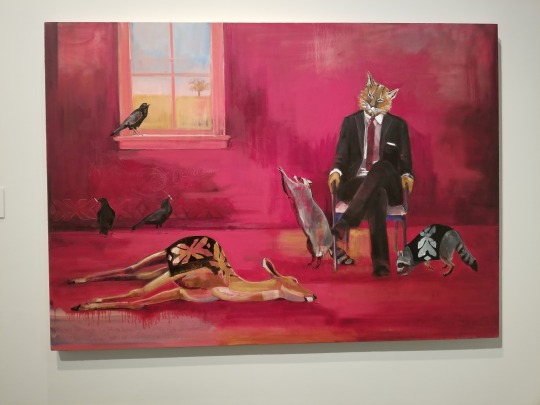
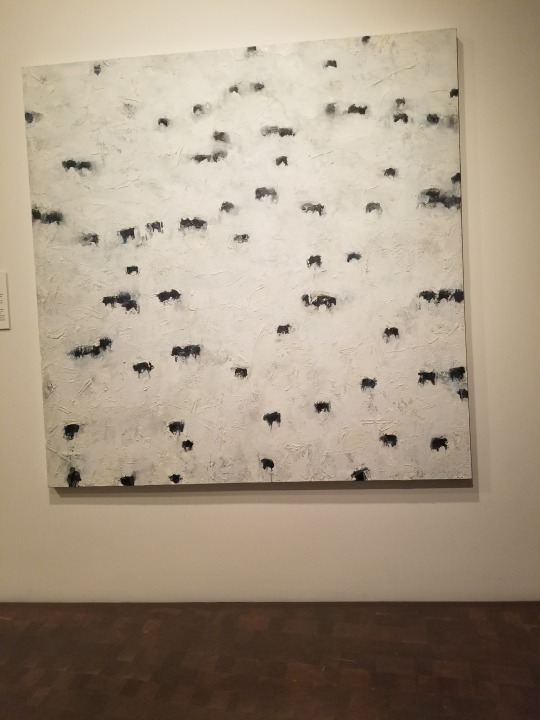
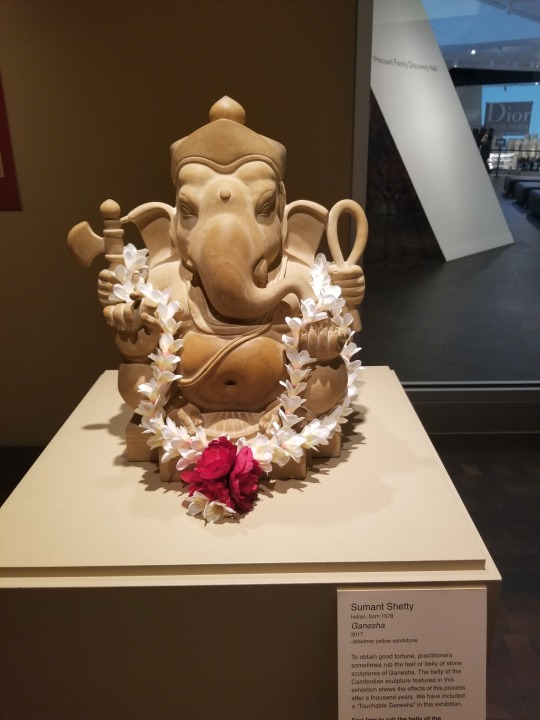
1 note
·
View note
Text
Media Culture & Society- Media Coverage of Women’s Sports
100 word analysis of how Messner examines sports, power, and coverage. Choose a specific sport to analyze and discuss, using the article as a lens through which to examine the sport.
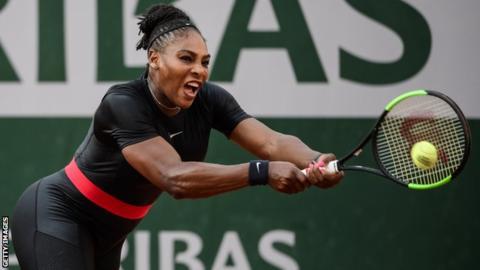
Michael Messner’s Chapter 4 “Center of Attention: The Gender of Sports Media” was very interesting to me especially since I recently read the culmination of Messner’s research in his article “It’s Dude Time: A Quarter Century of Excluding Women’s Sports in Televised News and Highlight Shows”. This latest article, written in 2015, shows a decrease in TV coverage of women’s sports since the 1990s. In Chapter 4, Messner discussed the many ways women athletes and nonathletes were sexualized. That has decreased since that Chapter was written but it has been replaced with polite bland recaps of women’s sports that have arguably done worse for the coverage of women’s sports. This coverage makes women’s sports seem boring compared with the coverage that men’s sports get. Commentators and announcers bring men’s sports to life even if it is a boring game with expressive language and exciting tone. If there is a story on a women’s sports, then it is delivered by obligation not because the announcers want to share the story. Also, women athletes are often painted in the media by their relationships to men. For example, Serena Williams, debatably the best tennis player in the world, is constantly painted as a mother and a wife in dominant sports media’s narratives. Along with reinforcing heteronormative values, it shows that no matter how exceptional a woman may be at her sport she is still nothing without a man and is meaningless to hegemonic society if she doesn’t have relationships with men. Another example from Serena is how earlier in her career the media constantly told the story of how her father taught her sister Venus and her tennis from an early age on the tennis courts in Compton. While her father’s ambition and drive to teach Venus and Serena is admirable, it is his daughters’ talent, drive, and athleticism that have helped them succeed not their dependence on their father.
1 note
·
View note
Text
Subcultures
100 word analysis of the term subculture. How do certain objects and occurrences affect different subcultures? How can subcultures be influential? Along with that, mention a time where a dominant subculture is present. How did that subculture affect the society of that time, and how did that subculture signify a change in society? Minimum word 100 word analysis with example.
A subculture is a cultural group within a larger culture, whose members are often times deemed outsiders for being different. Laws, events, and occurrences can all prove to change these subcultures both directly and indirectly. For example for many years gay marriage was a topic of discussion and debate, and many gay couples were not allowed legal marriage and the benefits that come along with marriage(e.g government benefits for health care) until laws were passed throughout the US which allowed gay couples to gain the same benefits that come with matrimony as their straight counterparts. Subcultures much like the homosexual community are usually outnumbered by those who belong to the main dominant culture of society. Throughout history subcultures were seen as the oppressed and hated because of how different they were to the “normal” and “upstanding” members of society. Much like how the pro African American subculture of Whites in America were often times hated by their own. Although the pro African American subculture was seen as miniscule and insignificant in the eyes of racist Caucasians, the subculture managed to inspire change and reform through protests and rallies because although they were the oppressed they still outnumbered the hateful people in America.
1 note
·
View note
Text
“Mapping Media Studies”
Mapping Media Studies Minimum 100 word analysis of how you interpret the idea of “mapping media studies.” How do you currently consume media and in what ways might the tools discussed in this reading prepare you for opening up and challenging the ways you consume and produce media? What do you think are some of the biggest issues in media today (social media; news; advertisements; music; TV; film)?
Media plays a significant role in how individuals react and perceive different events which occur in modern day society. This is because with the heavy amounts of time and interest that modern day youth, and even the president of the United States, invests in social media, it is easier for one to become overly encumbered with the rest of the population’s politically correct answers and opinions, to the point where one’s own no longer matters as one tends to side with the popular belief; whether it has to do with religious, political, or even societal issues, e.g. racism. I myself have fallen victim to this truth and I believe the sense of “brain washing” that occurs with in media is one of the most troubling issues along with the fact that as Americans we have constant unfiltered access to this “brain washing” of sorts, which is often written and targeted to a certain audience. This is seen in all forms of media not only social media but in also movies and commercials which target certain individuals to act or think in a certain way, much how like alcohol and tobacco companies target young adults to indulge in their products; hoping that they will become drawn in in order to provide a sizable profit for their corporations. This is a very troublesome truth about media as it not only takes one’s sense of individual thinking out of the picture but may also cause younger audiences to fall prey to brainwashing. The tools discussed in the article “Mapping Media Studies” may help with me personally being able to understand why some people, myself included, may find certain things within media appealing and or politically correct, whether it may be due to their geographical standing, environmental experiences, etc. The ideas presented in the article will help me challenge these truths and beliefs and will make me think twice before producing media.
2 notes
·
View notes
Text
Midterm Analysis
In the hit show Black Mirror problematic societal norms are examined by the writers in order to express the detrimental effects social media and technology can have on our culture. In the series’ episode “Nosedive” the writers of the show follow the life of a single middle class woman named Lacie who wishes nothing more than to climb the social ladder and be seen as worthy by those around her. In the show’s hypothetical depiction of the future men and women are ranked and scored on the daily interactions they have with those in their everyday lives, these scores are later tallied up to one final overall rating. This rating serves to help people determine whether that person is “worthy” of social interactions and or benefits which companies offer, in Lacie’s case the benefit and aspiration of a high score: being able to gain twenty percent off the original price on an upper middle class white picket fence home, which she desires in order to further better her score.
In the episode Lacie wears a mask and puts on a façade in order to be seen as the perfect feminine woman, which in turn makes her more likeable to those in the show and thus improves her score. The grading system depicted by the show is analogous to what Susan Bordo speaks of in her article “The Empire of Images”. This is because Bordo expresses the sense of need and want we as active members of society have to fit into the societal norms placed on us by media. Much like how Bordo explains that “there’s a limit...to what fruit acids can do,”(Bordo 3) in order to improve one’s physical appearance, there is also a limit to what fake laughs and smiles (which are both acts Lacie commits to in order to better her social standing) can do in regards to making you a more likeable person in the eyes of those around you. Sometimes simple acts like that are not enough to be deemed worthy by your peers, no.. instead one must undergo “aesthetic tinkering”(Bordo 4) in order to better wear this imaginary mask. Although Bordo speaks of this mask in a more physical and tangible way, in terms of undergoing plastic surgery, the show depicts this idea of “aesthetic tinkering” for personal gain in a more abstract way. This way being: undergoing “social plastic surgery” which in terms of the show means extending one’s social circle to include “high quality people”, i.e. those with a score of 4.5 and higher. By doing so Lacie and the other members of this hypothetical reality can gain approval and a sense of belonging, but what if one does not have the proper score in order to undergo this catharsis? What about “ The rest of us … who can not afford…aesthetic tinkering.”(Bordo 4)? That is to say those without the proper means to easily climb the social ladder through predisposed conditions have to work a lot harder to receive what they desire. For example, a person born into wealth can easily and freely undergo plastic surgery in order to gain higher ground on the social ladder, meanwhile those who are not born with this luxury can not do the same and have to work much harder to obtain their goal (eg. gaining larger glutes through exercise) and are thus seen as less for it.
Media has “revealed a persistent pattern (of) underrepresenting working class occupations and over representing professional and managerial positions”(Butsch 507). It is often common place that media places a stigma on those who require a blue collar job in order to make ends meet while those who do not require such an occupation are portrayed as better for it. A character flaw is often placed in media upon those who are not wealthy enough to pay off their expenses in a careless and easy way. A prime example of this is shown in media when “working class men (are) portrayed as buffoons”(Butsch 507), which ingrains into the viewers’ heads that those who are not educated or wealthy enough to be part of the social hierarchy should be deemed inferior when put in comparison to their wealthy counterparts. In Black Mirror Lacie is part of the blue collar working class as she has to strive in order to get what she wants in life, unlike the person she wishes to be more like, Naomi, who does not require such a job in order to sustain her lavish life. In the episode Naomi is portrayed as a perfect member of society, so to speak, as she is depicted as the typical sexy trophy wife who always acts accordingly in every social situation, and then there’s Lucie who expresses various character flaws when things do not go as planned, expressing both anger and naivety during such events. This is also seen in the episode when most of the working class community Lacie encounters are always scored as 3.4s or lower, essentially stating that simply because these workers hold a typical and unspectacular job title, they should also be deemed as typical and unspectacular. This leads one examining the show through a Marxist lens to question the reason why these workers hold these blue collar jobs, is it because they are terrible people? The show leaves this answer as a possibility because many of the customer service workers depicted in the show have some sort of character flaw which can account for their low social standing. This is seen in many occasions but one event in particular which expresses this idea is when Lacie approaches the car charging station clerk to ask for help, as he removes his earbuds one can hear the moaning of a woman, presumably coming from a pornographic video the clerk is watching. Thus leading one to believe that the station clerk is a perverse human being which is the reason why he sits so very low on the social totem pole.
1 note
·
View note
